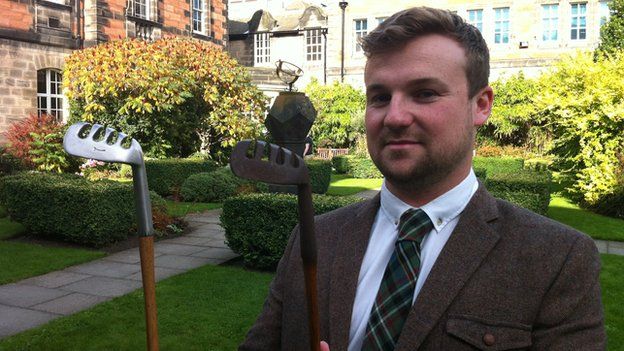Researchers recreate historic golf clubs in 3D printer
- Published

Researchers in Dundee have created a 3D-printed replica of a 125-year-old golf club.
Members of Dundee University's mechanical and electrical engineering division teamed up with the St Andrews Golf Company to make metal copies of historic clubs.
The team replicated two historic irons loaned to them by the British Golf Museum in St Andrews.
It is hoped the project will help protect rare and ancient golf clubs.
In a cross-European effort, the head of a 125-year-old rake iron was scanned in Dundee, printed in Germany and drilled in Glasgow before being finished in St Andrews.
The project marks the first time a metal club-head has been created using a 3D printer.
Grant Payne of the St Andrews Golf Company hopes re-created clubs can be used as teaching aids in museums and in areas of the world where there is little historical understanding of the game.
"Studying the evolution of golf clubs is one of the best ways of learning about the game's history," he said.
"The two clubs we looked at are interesting because they date from a time that was known as golf's era of innovation, when the sport as we know it today really came into being."
Rake iron
The two clubs studied by the university team were a "President" water iron, which was made in 1885 in Anstruther, and a rake iron dating back to about 1890,
The rake iron was invented by an optometrist, believed to have lived in Montrose, who became fed up of having to remove sand from the eyes of golfers playing at the local links, and created a club designed to cast up less sand when swung.
The head of the club was scanned with a 3D scanner at Dundee University, before the data was sent to German company EOS, who spent 29 hours printing a replica using a process called metal laser sintering.
The piece, which retains the dents and damage collected over the original club's 125-year lifespan, was then sent back to St Andrews for finishing with a hickory shaft and grip.
However it had to come to Fife via Glasgow, after it emerged the club head was so strong it could only be drilled into to make a hosel for the shaft using high carbide drills at the University of Strathclyde.
- Published27 January 2014
- Published22 May 2013